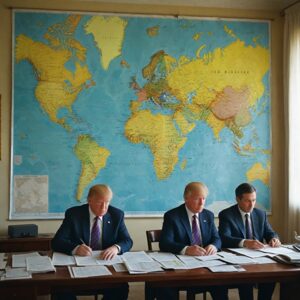Summary
The Exciting News Alert: Trump to Unveil New Semiconductor Tariff Plan Next Week refers to a major trade policy initiative announced by former U.S. President Donald Trump in early 2025, aimed at imposing new tariffs on imported semiconductors and related products. This plan, grounded in Section 232 of the Trade Expansion Act of 1962, represents a strategic effort to bolster domestic semiconductor manufacturing, reduce reliance on foreign suppliers—particularly from China—and address national security concerns tied to the global technology supply chain.
The proposed tariffs cover a broad range of semiconductor-related goods, including chips, substrates, manufacturing equipment, and downstream electronics containing semiconductors. By incentivizing reshoring of chip production, the administration sought to mitigate vulnerabilities in critical industries such as defense and advanced technology manufacturing. The plan follows earlier trade measures under both the Trump and Biden administrations, including export controls and targeted tariffs on technology products, and is part of a broader push to reverse the U.S. trade deficit and restore industrial competitiveness.
However, the tariff initiative has sparked significant debate and controversy. Critics warn that the tariffs could increase costs for U.S. manufacturers and consumers, disrupt complex global supply chains, and provoke retaliatory tariffs from key trade partners like China and the European Union. Additionally, the practical challenges of rapidly expanding domestic semiconductor fabrication capabilities, coupled with the global interdependence of chip production, raise questions about the immediate effectiveness of the tariffs.
Despite these concerns, supporters argue that the tariffs form an essential component of a comprehensive strategy to rebuild America’s semiconductor industry, enhance national security, and create well-paying domestic jobs. The policy underscores ongoing tensions between protectionist trade measures and the realities of a globally integrated technology sector, highlighting the complex balance between economic, security, and diplomatic priorities in U.S. trade policy.
Background
In early 2025, the Trump administration initiated a major policy effort targeting the semiconductor industry as part of its broader strategy to bolster domestic manufacturing and address national security concerns. President Donald Trump announced plans to impose new tariffs specifically on imported semiconductors, signaling a shift from previously granted temporary exemptions on certain electronics products, including smartphones and computers. These tariffs are to be implemented under Section 232 of the Trade Expansion Act of 1962, which authorizes the president to restrict imports deemed critical to U.S. national security.
The scope of the investigation encompasses a wide array of semiconductor-related products, such as semiconductor substrates, bare wafers, legacy and leading-edge chips, microelectronics, semiconductor manufacturing equipment components, as well as downstream electronics that incorporate semiconductors. The administration’s stated objective is to encourage reshoring of semiconductor manufacturing capabilities to the United States, reducing dependency on foreign sources, particularly China, which remains the largest supplier of electronic products to the U.S.. President Trump and key officials, including Commerce Secretary Howard Lutnick and National Economic Council Director Kevin Hassett, emphasized the strategic importance of semiconductors, which are essential components in defense equipment and various critical technologies.
Despite temporary relief from reciprocal tariffs on technology imports announced in April 2025, these exemptions are set to be replaced by targeted semiconductor tariffs within months. The administration has also called for public comments on the investigation to assess the feasibility of expanding domestic semiconductor production capacity and whether additional trade measures are warranted to protect national security. This approach mirrors previous tariffs on steel and aluminum, aiming to stimulate domestic industry growth while addressing perceived vulnerabilities in global supply chains.
The policy has stirred concerns regarding increased costs for consumer electronics and potential retaliatory measures by trade partners, particularly China and Europe, which could further complicate global semiconductor supply chains. While the Biden administration’s CHIPS Act allocates $50 billion in incentives to boost U.S. chip manufacturing, Trump has criticized such subsidies, arguing that tariffs alone will be sufficient to drive factory relocations to the United States. However, challenges remain, including delays in establishing advanced chip fabrication plants domestically and the complex interdependence of global suppliers, which could limit the immediate impact of reshoring efforts.
Announcement
On January 27, 2025, President Donald J. Trump announced plans to introduce new tariffs on computer chips, semiconductors, and pharmaceuticals as part of a national security trade probe. The administration cited Section 232 of the Trade Expansion Act of 1962 as the legal basis for this investigation, which allows the president to impose tariffs to protect U.S. national security interests. The probe will cover a wide range of semiconductor-related products including semiconductor substrates, bare wafers, legacy and leading-edge chips, microelectronics, and components used downstream in electronics manufacturing.
Although certain electronics products such as smartphones and other consumer electronics were initially exempted from the reciprocal tariffs imposed on Chinese imports, Commerce Secretary Howard Lutnick clarified that this relief was temporary and that these products would soon be subject to new semiconductor tariffs expected within the following months. The administration’s goal with the tariffs is to incentivize the relocation of semiconductor production back to the United States, reducing dependence on foreign suppliers from countries such as Taiwan, South Korea, and the Netherlands.
The announcement followed a series of earlier measures by the Biden administration, including export controls on advanced U.S. semiconductor technologies citing national security concerns, which the Trump administration has now taken over for implementation. President Trump’s approach also involved expanding reciprocal tariff exceptions to various semiconductor-related Harmonized Tariff Schedule codes, as outlined in a presidential memorandum issued in April 2025.
Trade officials indicated that while no immediate talks with China on tariffs were planned, the administration aimed to negotiate meaningful trade deals with several countries within 90 days. However, China had already responded with retaliatory tariffs, including an increase to 125% on certain U.S. imports. The imposition of these tariffs raised concerns about increased costs for consumer electronics and the potential for escalating trade tensions with global partners.
Tariff Details and Scope
In May 2024, the Biden administration decided to retain and increase Section 301 tariffs on $18 billion worth of goods, with new rates ranging from 25 to 100 percent. These tariffs specifically target semiconductors, steel and aluminum products, electric vehicles, batteries and battery parts, natural graphite and other critical materials, medical goods, magnets, cranes, and solar cells. The ongoing tariff measures build on earlier actions, such as the Trump administration’s imposition of tariffs on washing machines and solar cells in 2018, following a Section 201 investigation.
The semiconductor tariffs have been a focal point of trade policy due to their critical role in technology and national security. Despite some initial exemptions on electronics products such as smartphones, computers, and semiconductors, the U.S. Commerce Department confirmed that these products would eventually be included in the tariff plans as part of a broader investigation under Section 232 of the Trade Expansion Act of 1962. This statute permits the president to impose tariffs on imports deemed a threat to national security. The investigation encompasses a wide range of items including chip components, chipmaking equipment, and downstream products containing semiconductors.
President Trump articulated that the tariffs aim to encourage domestic manufacturing of critical technology components like semiconductors and chips, thereby reducing U.S. reliance on imports from countries such as Taiwan, South Korea, and the Netherlands. However, the tariffs also impact essential semiconductor manufacturing inputs such as steel, aluminum, electrical components, lighting, and water treatment technology, potentially complicating efforts to rebuild the U.S. semiconductor supply chain. Additionally, most advanced lithography machines, necessary for chip production, are imported from countries subject to these tariffs, including the Netherlands and Japan.
The tariffs not only target directly imported semiconductors but also include semiconductors embedded within other products. Given that many chips are integrated into devices assembled in Asia or Mexico, the U.S. government has been exploring ways to extend tariffs to these downstream products, though the current system does not fully accommodate such measures. The Office of the United States Trade Representative has been actively investigating how to apply tariffs on semiconductors contained in finished goods to bolster domestic manufacturing.
While tariff exclusions have been applied to several categories including certain copper products and pharmaceuticals, semiconductors remain subject to ongoing scrutiny and tariff imposition under the national security rationale. The Biden administration has also negotiated tariff suspensions with the European Union for certain goods, reflecting a complex balance between trade enforcement and diplomatic agreements.
The imposition of semiconductor tariffs has provoked international reactions, with countries like China imposing retaliatory tariffs on U.S. imports. The ambiguity and evolving nature of tariff policy have led to uncertainty within the semiconductor industry and global supply chains. Nonetheless, U.S. trade officials and advisors emphasize that these tariffs are intended to incentivize the relocation of semiconductor production to the United States, strengthening national security and economic competitiveness.
Objectives and Strategic Goals
The primary objective of the new semiconductor tariff plan is to address the longstanding and large U.S. trade deficit in goods, which exceeded $1.2 trillion in 2024, by promoting the reshoring of manufacturing and revitalizing the domestic industrial base. The plan aims to strengthen national and economic security by ensuring that critical components, such as semiconductors essential for defense equipment, are produced within the United States. This approach is intended to correct perceived injustices in global trade, incentivize advanced manufacturing capacity domestically, and reduce dependence on foreign adversaries for vital supply chains.
Strategically, the administration seeks to use tariffs as a tool to balance chronic trade deficits and encourage foreign partners to rebalance their trade relationships with the United States. This includes imposing tariffs on semiconductor imports and related manufacturing machinery, as well as on products containing chips, in an effort to support the development of a more resilient and secure semiconductor industry in the U.S.. The tariffs also serve as part of a broader, long-term strategy to rebuild America’s semiconductor manufacturing capacity, which could take several years to fully materialize.
Furthermore, the plan reflects a desire to coordinate with allied nations, recognizing that the U.S. accounts for only about a quarter of global demand for chip-containing goods, and that working multilaterally is critical to countering challenges such as Chinese chip oversupply. However, the policy has faced criticism for potentially undermining the national sovereignty of allied countries and increasing costs for American workers in semiconductor-related industries. Additionally, the potential impact on the import costs of advanced lithography machines from countries like the Netherlands and Japan could complicate efforts to onshore semiconductor manufacturing.
Impact Assessment
The implementation of President Trump’s semiconductor tariff plan is expected to have wide-ranging effects on the U.S. economy, global supply chains, and international relations. While the tariffs are designed to incentivize reshoring of semiconductor manufacturing and address trade imbalances, their immediate and medium-term impacts present a complex mix of benefits and challenges.
Economic and Industrial Effects
In the near term, the tariffs are likely to increase costs for thousands of U.S. manufacturers that rely heavily on semiconductors, many of which do not have domestic alternatives readily available. This cost increase stems from tariffs applying not only to imported chips but also to semiconductors embedded within other imported devices, potentially raising expenses for a broad array of consumer electronics and industrial products. Moreover, the higher costs could translate to an average tax increase of nearly $1,300 per U.S. household by 2025, reflecting the broader economic burden on consumers.
Despite these short-term challenges, proponents argue that the tariffs form part of a broader strategy aimed at revitalizing American chip manufacturing. This approach includes domestic manufacturing incentives, preferential tax credits for chip purchases, deregulation, and export controls designed to limit advanced chip technology access to China. Over the long term, this strategy may help the United States regain some lost semiconductor market share and bolster national economic security through increased domestic production capacity.
Supply Chain and Geopolitical Implications
The semiconductor tariffs also pose significant risks to global supply chains, adding cost, complexity, and strategic uncertainty for companies in the technology sector. Given the semiconductor industry’s reliance on international partnerships, especially with countries like Taiwan—which hosts key manufacturers such as Taiwan Semiconductor Manufacturing Company (TSMC)—the tariffs disrupt established trade patterns. While some semiconductor exports from Taiwan are exempt, the majority are still affected, creating ripple effects across allied economies.
Additionally, the tariffs risk heightening geopolitical tensions, particularly with China and Europe, possibly triggering retaliatory measures that could impact other industries. The administration’s assertive trade posture, including export controls and unilateral tariff impositions, has raised concerns about undermining allied national sovereignty and promoting a fragmented global market.
Challenges in Domestic Semiconductor Expansion
Efforts to ramp up U.S.-based chip production face practical hurdles, including delays in large-scale manufacturing projects such as TSMC’s $65 billion investment in multiple fabrication plants. These challenges underscore the difficulty of quickly establishing advanced semiconductor manufacturing domestically, meaning many U.S. firms will continue to depend on foreign partners for critical components. The uncertainty around trade compliance and shifting policy landscapes further complicates supply chain management and long-term planning for affected businesses.
Comparison with Previous Tariff Measures
The new semiconductor tariff plan announced by the Trump administration reflects both a continuation and an intensification of prior trade policies aimed at bolstering U.S. manufacturing and addressing trade imbalances. Unlike earlier tariffs implemented under Section 232 and Section 301, which broadly targeted steel, aluminum, and various critical materials, the forthcoming tariffs are more specifically focused on the semiconductor and electronics supply chain—a sector deemed vital to national security.
Under the Biden administration in 2024, Section 301 tariffs were retained and even increased on approximately $18 billion worth of goods, including semiconductors, steel and aluminum products, electric vehicles, batteries, and other critical materials, with rates ranging from 25 to 100 percent. However, some exclusions were maintained for certain items such as semi-finished copper, pharmaceuticals, and lumber, which are also part of Annex II to the executive order. In contrast, the Trump-era semiconductor tariffs have been described as part of a broader, more protectionist strategy emphasizing reshoring and restoring U.S. manufacturing capacity, accompanied by export controls and favorable tax policies.
While previous tariffs sometimes excluded goods already in transit or set rate ceilings (e.g., not exceeding 15 percent for certain goods under the Biden administration), Trump’s approach signaled fewer exemptions and a focus on leveraging tariffs as a tool to compel reciprocal trade practices and reduce the chronic U.S. goods trade deficit. Moreover, Trump’s measures sought to address a national emergency declared due to foreign trade practices that were perceived as undermining the U.S. manufacturing base and defense-industrial capacity.
The announcement also highlighted the challenges faced by domestic chipmakers, as delays in investments such as TSMC’s $65 billion fab projects underscored the complexity of rebuilding advanced semiconductor manufacturing in the U.S.. Earlier tariff implementations granted temporary reprieves for electronics products like smartphones and computers, but these were often viewed as short-term measures preceding the imposition of more targeted semiconductor tariffs.
Legal and International Trade Considerations
The proposed semiconductor tariffs by the Trump administration are grounded in legal authority provided by Section 232 of the Trade Expansion Act of 1962, which empowers the president to impose tariffs to protect national security interests. This legislation has been invoked previously for steel, aluminum, autos, and other critical materials, and now extends to semiconductors and related products to incentivize reshoring of manufacturing and reduce reliance on imports.
While the United States maintains one of the lowest average Most Favored Nation (MFN) tariff rates globally, at 3.3 percent, many key trading partners such as Brazil, China, the European Union, India, and Vietnam have significantly higher rates, underscoring long-standing disparities in global trade practices. The administration’s tariffs seek to address
Reactions and Responses
The announcement of President Trump’s new semiconductor tariff plan has elicited a wide range of reactions from industry experts, government officials, and international stakeholders. Supporters argue that the tariffs are a necessary step to strengthen the U.S. economy, promote domestic manufacturing, and address longstanding trade imbalances. A 2024 study credited the tariffs with strengthening the U.S. economy and leading to significant reshoring in key industries such as manufacturing and steel production. The administration emphasized that the tariffs are part of a broader reciprocal trade agenda designed to protect national security and restore American manufacturing dominance.
However, the plan has also raised concerns about its broader economic and geopolitical implications. Critics warn that the tariffs risk heightening geopolitical tensions, particularly with China and European allies, and may provoke retaliatory measures that could disrupt other industries. The unilateral nature of some policies has been criticized for threatening the national sovereignty of allied countries and setting a dangerous precedent in international trade relations. Additionally, businesses face increased uncertainty and complexity navigating compliance with the new trade restrictions, which may lead to supply chain disruptions and increased costs.
Industry analysts have suggested that while tariffs could be effective if integrated into a comprehensive strategy—including domestic manufacturing incentives and tax credits—the United States cannot achieve its semiconductor ambitions in isolation. Given that the U.S. accounts for only about a quarter of global demand for chip-containing goods, cooperation with allied nations is critical to manage supply and demand effectively. Furthermore, delays in key domestic manufacturing projects, such as TSMC’s $65 billion investment in U.S. fabs, highlight the challenges in ramping up advanced chip production within the country.
The tariffs also pose risks to American workers in semiconductor equipment manufacturing and software design, as well as to global companies reliant on intricate supply chains. While some countries under existing U.S. sanctions, such as Russia and North Korea, were excluded from the tariff list, American allies like Taiwan—home to major semiconductor producers—are nonetheless affected due to the broad scope of tariff coverage on semiconductor-related exports. Despite these challenges, proponents maintain that the ultimate goal is to foster a robust, self-reliant semiconductor industry that secures critical technologies and creates well-paying American jobs.
Economic Analysis and Expert Opinions
The proposed semiconductor tariffs under the Trump Administration have sparked considerable debate among economists, industry experts, and trade analysts. Proponents argue that these tariffs are a strategic move to revive American manufacturing and address longstanding trade imbalances. A 2024 study found that tariffs implemented during President Trump’s first term “strengthened the U.S. economy” and contributed to significant reshoring in industries such as manufacturing and steel production. Supporters contend that these measures will drive economic growth by incentivizing domestic production of semiconductors and other critical goods, thereby creating better-paying American jobs and enhancing national security.
However, the practical implementation of semiconductor tariffs raises concerns about increased costs and supply chain disruptions. Analysts warn that the tariffs would elevate costs for thousands of U.S. manufacturers who rely heavily on imported chips, many of which currently have no viable domestic alternatives. While companies could theoretically restructure supply chains to source chips from domestic manufacturers, the transition is complex and not feasible in the short term for most businesses. The average tax increase attributable to tariffs is estimated at nearly $1,300 per U.S. household by 2025, underscoring the potential burden on consumers.
Industry experts emphasize the need for a comprehensive strategy that includes not only tariffs but also domestic manufacturing incentives and international cooperation. Jimmy Goodrich, senior adviser to the RAND Corporation, notes that tariffs could be effective “if used smartly” alongside preferential tax credits and efforts to curb Chinese chip oversupply, stressing that the U.S. alone accounts for only about a quarter of global chip demand. This highlights the importance of collaboration with allied nations to avoid exacerbating supply chain volatility and to maintain competitiveness.
Concerns about geopolitical ramifications are also prominent. The risk of retaliatory tariffs from China and Europe could further fragment the global semiconductor market, complicating operations for multinational corporations. Mark Wu, a Harvard Law School professor, warns that such unpredictability may increase risks for businesses embedded in the global supply chain. While Trump asserts that tariffs target foreign-made goods and exempt products manufactured within the U.S., the timeline to establish new semiconductor fabrication facilities spans several years, complicating immediate industry adjustments. Moreover, the Semiconductor Industry Association projects that by 2030, up to 58 percent of new jobs in semiconductor manufacturing and design may remain unfilled despite increased production.
Market analysts remain cautiously optimistic, suggesting a potential softening of the tariff stance in favor of broader trade agreements with countries such as China, Japan, and India, which might mitigate disruption to the technology sector. Nonetheless, the overall consensus is that the tariffs will introduce additional costs, complexity, and strategic risks to an already intricate and globally interconnected semiconductor industry. The Biden administration’s continuation and expansion of tariffs, including higher rates on semiconductors and critical materials, reinforce the persistence of a protectionist trade environment.
Implementation and Monitoring
The implementation of the semiconductor tariff plan under the Trump administration began with the initiation of national security investigations into imports of semiconductors, semiconductor manufacturing equipment, pharmaceuticals, and related downstream products. These investigations, conducted by the U.S. Commerce Department, were announced through Federal Register notices and sought public comments on the potential imposition of tariffs as a measure to protect national security. Despite initial exemptions granted to certain electronics products such as smartphones, computers, and some semiconductor devices, these reprieves were considered temporary, with plans to apply tariffs more broadly to the sector.
The administration emphasized the importance of increasing domestic semiconductor manufacturing capacity as part of the investigation’s objectives, exploring whether tariffs or other trade measures would be necessary to reduce reliance on foreign imports and enhance national security. Although some product categories were excluded from the tariffs pursuant to existing legal frameworks, such as the Trade Expansion Act of 1962 and its amendments, these exemptions were limited and subject to revision based on the outcomes of ongoing reviews.
Monitoring of the tariff impacts has been complicated by the evolving nature of the trade environment and the uncertainty businesses face regarding compliance. The volatility and risk surrounding trade policies have heightened the need for manufacturers and other stakeholders to maintain heightened supply chain visibility to manage vulnerabilities effectively. Subsequent reviews, including those under the Biden administration, have led to the retention and expansion of tariffs on semiconductors and related goods, with rates ranging from 25 to 100 percent on select items, further underscoring the ongoing nature of tariff enforcement and adjustment processes.
The government’s approach continues to evolve, reflecting shifts in policy priorities and the dynamic conditions of global supply chains, signaling that stakeholders in the semiconductor industry should anticipate continued changes and remain vigilant in tracking regulatory developments and compliance requirements.

























